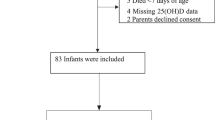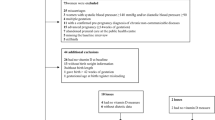Abstract
Objectives
To determine the prevalence and risk factors of vitamin D deficiency in pregnant women and their infants at birth (cord blood) and at six months of age in Turkey, as well as to assess the compliance rates of families with vitamin D supplementation.
Methods
Serum 25-hydroxyvitamin D [25(OH)D] level was measured of the mothers before delivery and of the infants both at birth (cord blood) and at six months of age. Infants who received and did not take regular vitamin D supplements were compared in terms of 25(OH) levels. Independent risk factors were determined by multiple logistic regression analysis.
Results
The study included a total of 140 pregnant women and their infants. Vitamin D deficiency was found in 95.7% of the mothers. The prevalence of vitamin D deficiency was 87.1% in infants at birth but decreased to 5.8% at sixth month. 65.7% of infants received vitamin D supplements regularly. Despite regular vitamin D use, it was determined that 2.2% of the infants in the supplementation compliant group had vitamin D deficiency. Maternal age, maternal education level, and the number of siblings were determined to be determining factors on infants’ 25(OH)D levels at six months (p < 0.05).
Conclusions
In Turkey, vitamin D deficiency still exists in both pregnant women and infants. Healthcare professionals and the public need to be more educated about the importance of regular supplementation. Serum 25(OH)D levels of infants should be tested periodically and personalized vitamin D supplementation planning is required based on test results.
This is a preview of subscription content, access via your institution
Access options
Subscribe to this journal
Receive 12 print issues and online access
$259.00 per year
only $21.58 per issue
Buy this article
- Purchase on Springer Link
- Instant access to full article PDF
Prices may be subject to local taxes which are calculated during checkout


Similar content being viewed by others
Data availability
The data sets generated and/or analyzed during the current study are not publicly available due to the data confidentiality requirements of the ethics committee but are available from the corresponding author on reasonable request and approval from the ethics committee.
References
Kulie T, Groff A, Redmer J, Hounshell J, Schrager S. Vitamin D: an evidence-based review. JABFM. 2009;22:698–706.
Deluca HF. Overview of general physiologic features and functions of vitamin D. Am J Clin Nutr. 2004;80:1686–9.
Bikle D. Nonclassic actions of vitamin D. J Clin Endocrinol Metab. 2009;9:26–34.
Hyppönen E, Läärä E, Reunanen A, Järvelin MR, Virtanen SM. Intake of vitamin D and risk of type 1 diabetes: a birth-cohort study. Lancet 2001;358:1500–3.
Lappe JM, Travers-Gustafson D, Davies KM, Recker RR, Heaney RP. Vitamin D and calcium supplementation reduces cancer risk: results of a randomized trial. Am J Clin Nutr. 2007;85:1586–91.
Walker VP, Modlin RL. The vitamin D connection to pediatric infections and immune function. Pediatr Res. 2009;65:106–13.
Alpdemir M, Alpdemir MF. Meta-Analysis Vitamin D deficiency status in Turkey: A meta-analysis. Int J Med Biochem. 2019;2:118–31.
Halicioglu O, Aksit S, Koç F, Akman SA, Albudak E, Yaprak, et al. Vitamin D deficiency in pregnant women and their neonates in spring time in western Turkey. Paediatr Perinat Epidemiol. 2012;26:53–60.
Aghajafari F, Field CJ, Weinberg AR, Letourneau N. APrON study team. both mother and infant require a vitamin D supplement to ensure that infants’ vitamin D status meets current guidelines. Nutriens. 2018;10:429.
Aghajafari F, Nagulesapillai T, Ronksley PE, Tough SC, O’Beirne M, Rabi DM. Association between maternal serum 25-hydroxyvitamin D level and pregnancy and neonatal outcomes: systematic review and meta-analysis of observational studies. BMJ. 2013;346:f1169.
Mohr SB, Garland CF, Gorham ED, Garland FC. The association between ultraviolet B irradiance, vitamin D status and incidence rates of type 1 diabetes in 51 regions worldwide. Diabetologia. 2008;51:1391–8.
Hatun S, Bereket A, Ozkan B, Coskun T, Köse R, Calıkoglu AS. Free vitamin D supplementation for every infant in Turkey. Arch Dis Child. 2007;92:373–4.
Hatun S, Ozkan B, Bereket A. Vitamin D deficiency and prevention: Turkish experience. Acta Paediatr. 2011;100:1195–9.
Gülez P, Korkmaz HA, Özkök D, Can D, Özkan B. Factors influencing serum vitamin D concentration in Turkish children residing in İzmir: A single-center experience. J Clin Res Pediatr Endocrinol. 2015;7:294–300.
Hurmuzlu Kozler S, Saylı TR. Factors influencing initiation and discontinuation of vitamin D supplementation among children 1-24-months-old. Curr Med Res Opin. 2021;10:1–7.
Halicioglu O, Sutcuoglu S, Koc F, Yildiz O, Akman SA, Aksit S. Vitamin D status of exclusively breastfed 4-month-old infants supplemented during different seasons. Pediatrics 2012;130:921–7.
Onal H, Adal E, Alpaslan S, Ersen A, Aydin A. Is daily 400 IU of vitamin D supplementation appropriate for every country: a cross-sectional study. Eur J Nutr. 2010;49:395–400.
Mutlu GY, Kusdal Y, Ozsu E, Cizmecioglu FM, Hatun S. Prevention of Vitamin D deficiency in infancy: daily 400 IU vitamin D is sufficient. Int J Pediatr Endocrinol. 2011;2011:4.
Koc F, Halicioglu O, Sutcuoglu S, Asik Akman S, Aksit S. Vitamin D supplementation during the first two years of life in Izmir, Turkey. Minerva Pediatr. 2014;66:141–6.
Holick MF, Binkley NC, Bischoff-Ferrari HA, Gordon CM, Hanley DA, Heaney RP, et al. Evaluation, treatment, and prevention of vitamin D deficiency: An Endocrine Society clinical practice guideline. J Clin Endocrinol Metab. 2011;96:1911–30.
Wolters M, Intemann T, Russo P, Moreno LA, Molnar D, Veidebaum T, et al. 25-hydroxyvitamin D reference percentiles and the role of their determinants among European children and adolescents. Eur J Clin Nutr. 2022;76:564–73.
Palacios C, Gonzalez L. Is D-vit deficiency a major global public health problem? J Steroid Biochem Mol Biol. 2014;144 PA:138–45.
Hollis BW, Wagner CL. New insights into the vitamin D requirements during pregnancy. Bone Res. 2017;5:17030.
Wang J, Zhang JY, Wei R, Hu S, Lin T, Lash GE. et al. Serum 25 hydroxyvitamin D status in 6‐month‐old infants in Guangzhou, China: A paired Longitudinal follow study. Matern Child. 2020;16:1294
Oktaria V, Graham SM, Triasih R, Soenarto Y, Bines JE, Ponsonby AL, et al. The prevalence and determinants of vitamin D deficiency in Indonesian infants at birth and six months of age. PLoS One. 2020;15:e0239603.
Perrine CG, Sharma AJ, Jefferds ME, Serdula MK, Scanlon KS. Adherence to vitamin D recommendations among US infants. Pediatrics 2010;125:627–32.
Dratva J, Merten S, Ackermann-Liebrich U. Vitamin D supplementation in Swiss infants. Swiss Med Wkly. 2006;136:473–81.
Alramdhan AM, El-Zubair AG. Poor vitamin D supplementation in infants. Cross-sectional study of maternal practices and awareness of vitamin D supplementation in infants in Al-Ahsa, Eastern Saudi Arabia. Saudi Med J. 2014;35:67–71.
Uday S, Kongjonaj A, Aguiar M, Tulchinsky T, Högler W. Variations in infant and childhood vitamin D supplementation programmes across Europe and factors influencing adherence. Endocr Connect. 2017;6:667–75.
Simon AE, Ahrens KA. Adherence to Vitamin D Intake Guidelines in the United States. Pediatrics. 2020;145:e20193574.
Elitok GK, Bulbul L, Bulbul A, Cigerli S, Uslu S. Vitamin D levels of 12–24-month-old healthy children in Turkey who received vitamin D supplementation until the age of one-year. Arch Argent Pediatr. 2020;118:95–101.
Korchia G, Amitai Y, Moshe G, Korchia L, Tenenbaum A, Rosenblum J, et al. Vitamin D deficiency in children in Jerusalem: the need for updating the recommendation for supplementation. Isr Med Assoc J. 2013;15:333–8.
Hunter D, De Lange M, Snieder H, MacGregor AJ, Swaminathan R, Thakker RV, et al. Genetic contribution to bone metabolism, calcium excretion, and vitamin D and parathyroid hormone regulation. J Bone Min Res. 2001;16:371–8.
Rodd C, Jean-Philippe S, Vanstone C, Weiler H. Comparison of 2 vitamin D supplementation modalities in newborns: adherence and preference. Appl Physiol Nutr Metab. 2011;36:414–8.
Unsur EK. Vitamin D levels of the healthy infants using oral spray or drop form of vitamin D supplement in the first year of life. North Clin Istanb. 2021;8:31–36.
Author information
Authors and Affiliations
Contributions
BH contributed to the conceptualization and design of the study; BH and RE recruited the patients and collected the data; BH and HKY contributed to the acquisition and analysis of data; BH contributed to the interpretation of data; BH drafted the manuscript. All authors have read and agreed to the published version of the manuscript.
Corresponding author
Ethics declarations
Competing interests
The authors declare no competing interests.
Additional information
Publisher’s note Springer Nature remains neutral with regard to jurisdictional claims in published maps and institutional affiliations.
Rights and permissions
Springer Nature or its licensor holds exclusive rights to this article under a publishing agreement with the author(s) or other rightsholder(s); author self-archiving of the accepted manuscript version of this article is solely governed by the terms of such publishing agreement and applicable law.
About this article
Cite this article
Hekimoğlu, B., Erin, R. & Yılmaz, H.K. Comparison of cord blood and 6‐month‐old vitamin D levels of healthy term infants supplemented with 400 IU/day dose of vitamin D. Eur J Clin Nutr 77, 182–188 (2023). https://doi.org/10.1038/s41430-022-01220-4
Received:
Revised:
Accepted:
Published:
Issue Date:
DOI: https://doi.org/10.1038/s41430-022-01220-4



